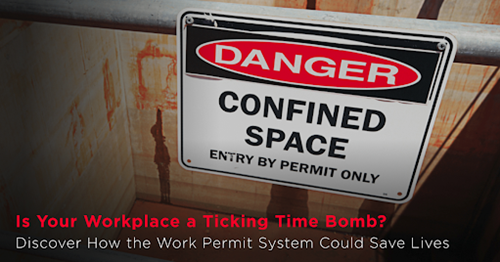Is Your Workplace Safe? Discover How the Work Permit System Could Save Lives!

Workplace safety might not be the most exciting topic, but it could literally mean the difference between life and death for your employees. Imagine heading into work unaware of hidden risks that could cause accidents, injuries—or worse. Could your workplace be a ticking time bomb? From construction sites to factories, high-risk environments demand strict safety measures. This is where the safety work permit system comes in—a practical, life-saving tool that ensures dangerous tasks are managed, risks are minimized, and everyone gets home safe at the end of the day.
The Alarming Reality of Workplace Safety
India continues to experience an unsettling rate of workplace fatalities, highlighting the urgent need for improved safety practices. According to IndiaSpend, an average of three workers lose their lives every day in Indian factories. To date, more than 6,500 workers have died, with incidents spanning across sectors like construction and manufacturing, as reported by DW News. Shockingly, five Indian states account for more than 75% of these fatalities, according to Business Standard.
These numbers not only reveal the scale of the problem but also emphasize how quickly a high-risk environment can turn deadly if safety measures are neglected. Let's understand what a work permit system is.
What is a Work Permit System?
The work permit system (WPS) is a formalized safety process designed to manage and control hazardous tasks. It ensures that workers follow strict protocols before starting any dangerous job, helping to prevent accidents. This system is crucial in reducing workplace incidents by laying clear guidelines for safe work practices.
Understanding the concept of a permit to work in safety is vital for high-risk industries like construction and manufacturing.
Critical Components of a Work Permit System
- Identification of Hazards: All risks are identified before the work begins.
- Risk Assessment: The risks are carefully assessed, and safety precautions are established.
- Authorization Levels: Only trained personnel can authorize the PTW system and its use.
A critical risk safety audit can help identify hidden risks that may not be immediately apparent.
What Are Common Types of Work Permits?
Hot Work Permit: This permit is required for welding, soldering, or cutting that generates heat or sparks. These tasks pose significant fire risks, making it essential to monitor flammable materials and ensure fire prevention measures are in place.
Cold Work Permit: This one is used for non-heat-generating tasks that still involve hazardous materials, such as chemical handling or routine maintenance. Although these tasks don't create heat, they can still present dangers, like exposure to harmful substances.
Confined Space Entry Permit: This permit is crucial for work in enclosed or partially enclosed spaces such as tanks, tunnels, or silos. Workers face risks such as suffocation, toxic gas exposure, and restricted escape routes. Strict protocols, including gas testing and rescue planning, are required before entry.
Industry-Specific Examples
Construction: Known as one of India's most hazardous sectors, the construction industry often sees accidents related to poor training and awareness of safety hazards. Many incidents involve falls, machinery mishaps, or structural failures. For detailed guidance, refer to British Safety Council India.
Manufacturing: This industry frequently experiences incidents like amputations due to improper machine handling or lack of safety training. Workers in manufacturing often face repetitive tasks with heavy machinery, increasing the risk of severe injuries if safety protocols aren't followed.
Oil and Gas: It is a particularly high-risk industry where flammable materials, explosive gasses, and high-pressure systems are common. The permit-to-work system is critical in this sector to ensure strict control measures are implemented for tasks like drilling, pipeline maintenance, and chemical processing.
The Benefits of Implementing a Work Permit System
Enhancing Safety Culture
Implementing a PTW system can significantly shift workplace culture, emphasizing safety first. In workplaces where a permit system is in place, incident rates have been shown to drop significantly, demonstrating how a step change in safety culture can lead to fewer accidents and improved employee morale.
Legal Compliance and Standards
A safety work permit system also ensures compliance with safety regulations, such as India's Occupational Safety, Health, and Working Conditions Code 2020 (OSHA). This legislation mandates that workplaces implement safety protocols, and a work permit system helps businesses meet these legal requirements, avoiding penalties.
How to Implement a Work Permit System?
Steps for Implementation
- Training Employees: All workers should be trained in the permit process.
- Clear Permit Templates: A simple and easy-to-understand permit template should be used for consistent documentation.
- Authorization: Only qualified personnel should issue permits.
Continuous Improvement and Monitoring
Continuous improvement is essential for a permit to work system to remain effective. Regular audits, like the Five Star Audit by the British Safety Council, help ensure that safety procedures are up to date and followed correctly.
Conclusion
A workplace without proper safety protocols can pose significant dangers, turning daily tasks into potential hazards. Implementing a work permit system allows businesses to mitigate these risks by ensuring that high-risk jobs are carefully managed and monitored. The system helps create a proactive approach to safety, ensuring compliance with safety regulations and protecting employees from harm. By adopting this system, companies reduce accident risks and demonstrate a commitment to fostering a safety culture. Don't wait for a crisis—start protecting your workforce today!
